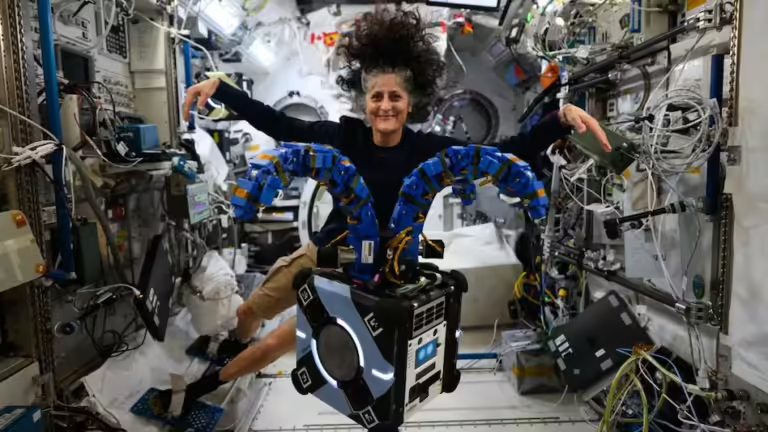NASA astronaut Suni Williams, known for her extensive work aboard the International Space Station (ISS), recently engaged in a groundbreaking demonstration involving the Astrobee robotic free-flyer during her time as Expedition 72 Commander. This innovative technology holds significant potential for the future of satellite maintenance and space debris management — two crucial areas for ensuring the sustainability of space activities.
Astrobee: A Revolutionary Robotic System
Astrobee, a free-flying robotic system developed by NASA, is designed to float through the microgravity environment of the ISS, assisting astronauts with various tasks. The system features a small, cube-shaped body equipped with advanced sensors, cameras, and propulsion systems. Astrobee is capable of navigating the ISS autonomously, offering astronauts a versatile tool for routine operations.
During Sunita Williams’ demonstration, Astrobee was used to showcase a new satellite-capture technology. The system’s tentacle-like arms are equipped with gecko-inspired adhesive pads, a design that mimics the remarkable ability of geckos to cling to surfaces. This technology could revolutionise satellite maintenance in orbit by providing a non-invasive method for capturing and repairing satellites.
The Astrobee system consists of three cubed-shaped robots, software and a docking station used for recharging. The robots use electric fans as a propulsion system that allows them to fly freely through the microgravity environment of the station. Cameras and sensors help them to “see” and navigate their surroundings. The robots also carry a perching arm that allows them to grasp station handrails in order to conserve energy or to grab and hold items.
Satellite capture
The ability to capture and service satellites in space has long been a challenge due to the complexity of space operations. Traditionally, satellites have been designed with limited lifespans, often ending their operational life in space due to mechanical failure or lack of fuel. The development of the Astrobee system, particularly its adhesive pads, aims to provide a solution to extend the operational life of satellites by enabling them to be serviced and repaired in orbit.
These tentacle-like appendages, inspired by gecko feet, use a sophisticated adhesive material that allows Astrobee to latch onto a satellite’s surface with remarkable precision. This technology could make it possible for robotic systems like Astrobee to capture and maintain satellites, replace components, or even refuel them without the need for expensive and risky spacewalks by astronauts. Such advancements could not only increase the longevity of vital satellites but also reduce the cost of space operations.
Space debris management
One of the biggest challenges facing space exploration today is the growing issue of space debris. Thousands of defunct satellites, spent rocket stages, and other remnants from space missions clutter Earth’s orbit, posing significant risks to operational satellites and space stations.
Astrobee’s satellite-capture technology could play a pivotal role in removing space debris. The ability to autonomously capture and deorbit satellites that are no longer in service would greatly alleviate the threat posed by this debris. In some cases, the Astrobee could be deployed to retrieve non-functional satellites or pieces of debris and guide them toward a controlled re-entry, reducing the risk of collisions and protecting valuable space assets.
Implications for future space missions
NASA’s work with Astrobee represents a significant step forward in the development of space robotics, with implications for both satellite maintenance and debris management. As technology evolves, systems like Astrobee could become integral to future space missions, making the environment safer for astronauts and more sustainable for satellite operations.
For Sunita Williams, an astronaut who has spent a significant amount of time aboard the ISS, this demonstration is another chapter in her groundbreaking career in space exploration. Her involvement in the Astrobee mission highlights the critical role astronauts play in testing and validating new technologies that will support the future of space exploration.
As we look to the future, advancements like Astrobee and its gecko-inspired satellite-capture technology could change the way we think about space sustainability. With the potential to extend satellite lifespans and mitigate space debris, these innovations pave the way for a more secure and efficient space environment, benefitting both current and future generations of space explorers.


